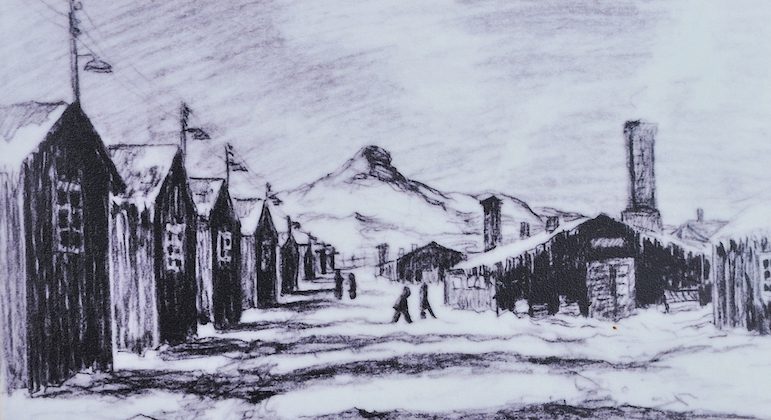Steve Prosinski permalink
Heart Mountain, rising between Cody and Powell in Park County, Wyo., towers over the site of what was the state's third-largest city from 1942 to 1945.
Last Best News (https://montana-mint.com/lastbestnews/2017/05/recalling-the-past-at-heart-mountain-interpretive-center/)
Heart Mountain, rising between Cody and Powell in Park County, Wyo., towers over the site of what was the state's third-largest city from 1942 to 1945.
After the attack on Pearl Harbor, President Franklin Roosevelt ordered the forced removal of all persons of Japanese ancestry from the West Coast.
The Heart Mountain Interpretive Center is open year-round and also will make appointments for visits.
A display at the interpretive center shows a photo of Japanese-Americans being checked in for transportation to a relocation center.
This memorial, dedicated in 1985, honors the more than 750 internees who left to serve in the U.S. Armed Forces during World War II. Fifteen Heart Mountaineers died in the war.
An ROTC student from Casper takes a photo of a display during a tour of the Heart Mountain Interpretive Center.
Incarcerees developed farm fields and grew 45 different crops, including broccoli, lettuce and corn, and Japanese crops such as kaikon, takena, mizuna and nappa. More than 5 million pounds of produce were harvested in 1944. Beets and barley are big today.
The Heart Mountain Honor Roll Memorial lists the men interned at Heart Mountain who served in the U.S. military during World War II. It is part of an interpretive walk on the bluff above the museum.
A walkway of commemorative bricks guides visitors to the front doors of the Heart Mountain museum.
A staff of 150 worked in the 17 wings of the hospital complex, which saw 5,486 admissions and 391 major surgeries in its three years of operation, according to camp records.
Members of the hospital staff worked in buildings like this. They included a white chief medical officer and chief nurse and Japanese-American physicians, nurses, nurse's aides, dentists, pharmacists and orderlies, according to museum materials.
The boiler and the chimney were part of a system that provided steam heat to the hospital buildings. Three of the original structures sit on the bluff above the interpretive center.
A replica of a guard tower rises near the museum. On the bluff behind the tower is the chimney that was part of the steam-heating system for the camp's hospital complex.
Staff members at the Heart Mountain Interpretive Center, located 11 miles from Powell and 14 miles from Cody, are eager to answer questions from visitors.
Estelle Ishigo, the white wife of a Japanese-American man, was paid $19 a month to sketch experiences she witnessed while living in the camp. On display at the museum is her image of internees boarding one of the last trains to leave the camp in 1945.

On display in the musem, this Estelle Ishigo image of a winter scene is one of many drawings in the Ishigo Collection.
POWELL, Wyo. — It sprang up almost overnight on arid, sagebrush-covered prairie and became Wyoming’s third-largest city, a community of more than 10,000 Japanese-Americans imprisoned after the attack on Pearl Harbor on Dec. 7, 1941.
Creation of the Heart Mountain Relocation Center, situated on 46,000 acres owned by the Bureau of Reclamation, was a boon to the local construction industry, which built many of the 650 buildings and structures at the camp.
Today, little remains.The boiler-house chimney and three weathered buildings on a bluff above the highway mark where a 150-bed, 17-wing hospital complex served internees.
They are the only structures still standing at the camp, which had two recreation halls, two mess halls and two buildings for laundries and public latrines. Internees lived in hundreds of hastily-built barracks, arranged in 20 blocks made up of 24 barracks buildings in each.
Trainloads of internees, allowed to bring only a suitcase of belongings and the clothes on their back, arrived at the camp disoriented and uncertain what would happen to them. Families — children, parents and grandparents — often found themselves housed in one-room quarters.
A new building, the Heart Mountain Interpretive Center, opened in 2011 through the efforts of The Heart Mountain Wyoming Foundation. That organization formed in the 1990s to preserve the site.
The Interpretive Center features photographs, paintings, artifacts, oral histories, interactive exhibits and a theater that help tell the stories of the Japanese-Americans confined there.Outside the center, walking trails and military memorials offer more information about the camp, which was the first of 10 to open in 1942, months after the Japanese attack on Pearl Harbor. Three years later, on the night of Nov. 10, 1945, passengers boarded the final train taking internees from the relocation center, and it closed.
The population of the camp peaked at 10,767 on Jan. 1, 1943. In the 1,187 days it was in operation, more than 14,000 incarcerees passed through its gates.
The Interpretive Center is featuring a temporary exhibit “Incarceration in Focus: A Comparative Look at the Photographs of Ansel Adams and Yoshio Okumoto.”
The exhibit features the photography of Adams and Okumoto, a former Heart Mountain incarceree.
Adams, the noted photographer, visited California’s Manzanar concentration camp in 1943. Manzanar was one of 10 sites where Japanese-Americans were held. Okumoto was Japanese-American internee sent to the Heart Mountain Relocation Center. There he developed an interest in photography.
Several photos of Okumoto and Adams are displayed side-by-side in a small gallery at the Interpretive Center. They provide interesting perspectives—one from Ansel, who was hired to document camp life for the government, and the other from Okumoto, who was imprisoned at Heart Mountain.
“Incarceration in Focus” runs through August and is included with museum admision.
The Interpretive Center is 14 miles northeast of Cody and 11 miles southwest of Powell on Highway 14A. Museum admission is $7 for adults and $5 for students and seniors. Children under 12 and members of the Heart Mountain Wyoming Foundation are free.
For more information, call 307-754-8000 or visit heartmountain.org.